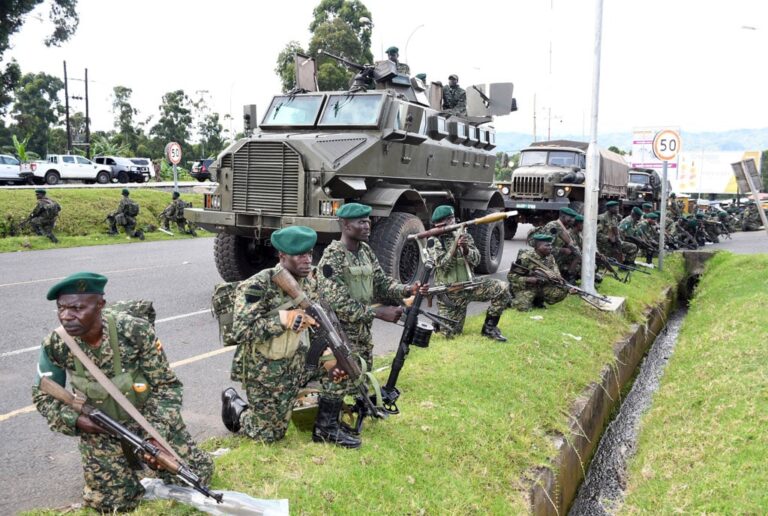Uganda has significantly increased its military presence in the eastern Democratic Republic of Congo (DRC), deploying over 1,000 additional soldiers near conflict zones where the Congolese government is engaged in fierce battles with the M23 rebels.
According to multiple diplomatic and United Nations (UN) sources, this latest reinforcement has raised concerns about a potential escalation of regional hostilities.
The newly deployed Ugandan People’s Defence Forces (UPDF) troops, numbering between 1,000 and 2,000, have been sighted advancing towards the front lines north of Goma, a strategic regional capital that has frequently been a flashpoint in the ongoing conflict.
The Rwandan-backed M23 recently captured Goma, further destabilizing the mineral-rich region that has been a battleground for multiple wars, including those from 1996-1997 and 1998-2003, which resulted in millions of deaths, primarily due to hunger and disease.
Uganda’s Military Objectives and Official Position
Officially, Uganda’s increased military deployment in the region is under the framework of Operation Shujaa, a joint offensive launched in 2021 with the Congolese government to combat the Allied Democratic Forces (ADF), an Islamist militant group responsible for numerous attacks and atrocities in eastern Congo.
The UPDF’s presence has already brought about significant pressure on ADF operations through coordinated ground and air assaults.
However, the new wave of deployments, which brings Uganda’s troop numbers in eastern DRC to an estimated 4,000-5,000, has led to speculation about the true nature of Uganda’s involvement.
The UN has previously reported that Uganda has allegedly provided logistical and training support to M23 rebels, despite officially backing President Felix Tshisekedi’s government against insurgents.
Ugandan officials have denied these allegations, insisting their primary mission remains the eradication of ADF strongholds.
Residents in Butembo, a key town in North Kivu province, reported seeing columns of UPDF soldiers moving southward towards the M23-controlled areas, a shift that could signal potential engagement beyond the ADF threat.
When asked about the troop movements, Ugandan army spokesperson Felix Kulayigye denied any major deployment but stated that forces had altered their “posture to offensive defense,” without elaborating further.
Regional Implications and Accusations of Strategic Interests
The presence of foreign troops in eastern Congo has long been a source of tension.
Rwanda, which has been accused of backing the Tutsi-led M23 rebels, also maintains a military presence in the region.
Uganda and Rwanda have both previously justified their incursions into eastern DRC as necessary for securing their borders against hostile militant groups.
However, both nations have faced accusations of exploiting Congo’s vast natural resources, including gold and other minerals.
Corneille Nangaa, leader of the Alliance Fleuve Congo, a coalition that includes M23 fighters, stated that Uganda does not provide direct support to the rebels but also does not act in hostility against them.
This ambiguous position raises further questions about Uganda’s long-term objectives in the region.
Adding to the complexity, Muhoozi Kainerugaba, son of Uganda’s President Yoweri Museveni and a key military figure, has previously expressed public support for Rwandan President Paul Kagame and his government.
In 2022, he referred to M23 fighters as “brothers of ours,” suggesting a level of ideological alignment with their cause of advocating for Congolese Tutsis.
Geopolitical and Economic Considerations
The deployment of additional Ugandan troops coincides with heightened geopolitical stakes.
Eastern Congo holds immense economic value due to its mineral wealth, and neighboring countries, including Uganda and Rwanda, have vested interests in the stability—or lack thereof—of the region.
Zobel Behalal, a senior analyst at the Global Initiative Against Transnational Organized Crime, emphasized that Uganda’s deepening involvement in eastern Congo is as much about economic and trade interests as it is about security concerns.
“The surge is a strategic move to ensure Uganda manages any spillover conflict while securing its economic and security interests in the region,” Behalal explained.
With M23 consolidating its hold over North Kivu and pushing towards Bukavu, approximately 200 km south of Goma, regional forces are under pressure to prevent further escalation.
While the Congolese government has expressed priority in combating ADF insurgents, there is growing concern that Uganda may find itself drawn into broader confrontations involving M23 and Rwandan forces.
Future Uncertainties
As fighting intensifies, the role of foreign troops in eastern Congo remains contentious.
The Congolese government has not officially confirmed the increased Ugandan deployment, and Communications Minister Patrick Muyaya has refrained from directly addressing the issue.
However, he acknowledged that UPDF forces are expected to remain focused on eliminating ADF elements, even as clashes with M23 and Rwandan units become increasingly likely.
Uganda’s military buildup in eastern DRC underscores the region’s fragile security situation and raises questions about the long-term consequences of foreign military involvement.
As regional alliances shift and conflicts evolve, the future of eastern Congo remains uncertain, with the specter of a broader war looming over an already volatile landscape.

